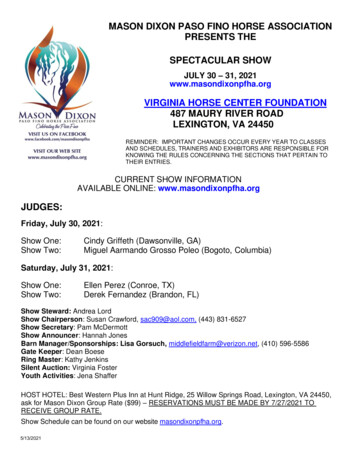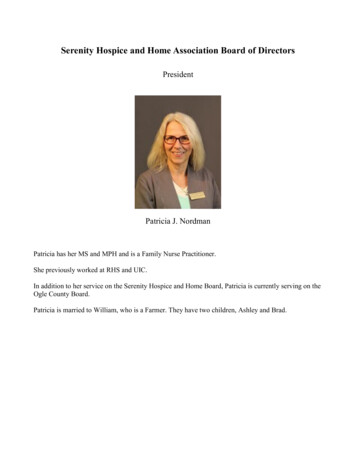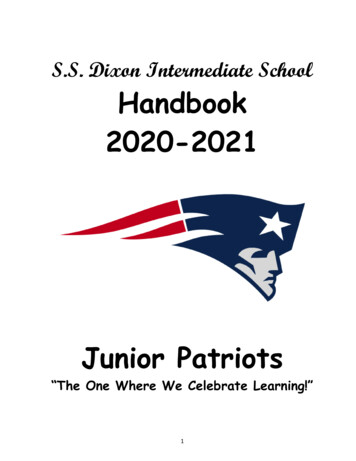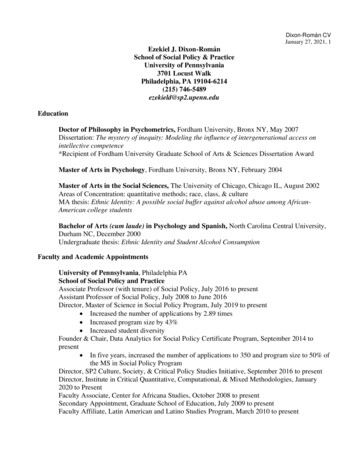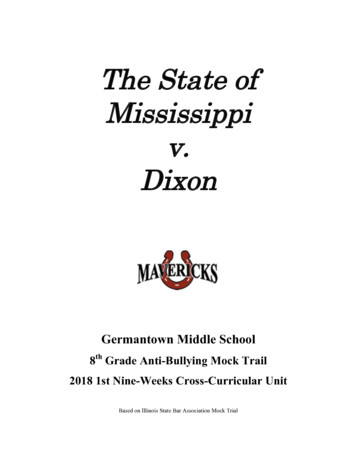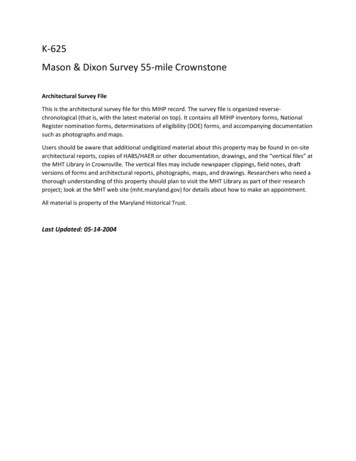
Transcription
K-625Mason & Dixon Survey 55-mile CrownstoneArchitectural Survey FileThis is the architectural survey file for this MIHP record. The survey file is organized reversechronological (that is, with the latest material on top). It contains all MIHP inventory forms, NationalRegister nomination forms, determinations of eligibility (DOE) forms, and accompanying documentationsuch as photographs and maps.Users should be aware that additional undigitized material about this property may be found in on-sitearchitectural reports, copies of HABS/HAER or other documentation, drawings, and the “vertical files” atthe MHT Library in Crownsville. The vertical files may include newspaper clippings, field notes, draftversions of forms and architectural reports, photographs, maps, and drawings. Researchers who need athorough understanding of this property should plan to visit the MHT Library as part of their researchproject; look at the MHT web site (mht.maryland.gov) for details about how to make an appointment.All material is property of the Maryland Historical Trust.Last Updated: 05-14-2004
K-6251766Mason & Dixon Survey 55-Mile CrownstoneNear Mi 11 ingtonPublicStanding about 100 feet south of the center of Maryland Route 291 east ofMillington, mile marker number 55 of the Maryland-Delaware north-southboundary (counting from the south end) is a "crownstone" that was set in 1766by the Mason and Dixon survey team. Standing about 25· high and measuringabout 12" square with a pyramidal top, the grey limestone monument, thoughweathered and chipped, still displays its original decorative elements. Themost notable are the shields on the east and west faces. The shield of theproprietary family of Maryland, the Calverts, faces west; the crown that is itstopmost element gave these five-mile markers the appellation of crownstone.Facing east is the shield of the Penn family, the proprietary family ofPennsylvania and its Three Lower Counties, the name for Delaware until 1776.This crownstone stands as Kent County's most visible silent reminder of thehistoric Mason-Dixon survey of 1763-68, a remarkably accurate survey thatsettled the longstanding dispute between the Lords Baltimore and the Pennfamily over the precise extent of the lands of each. One of nine mile markers,and one of only two crownstones, placed on Kent County's portion of theTangent Line (the north-south line), it is the only one that is easily accessibleand visible to the public and is also in reasonably good condition. Still servingas a boundary monument, it also documents the little-known fact that theMason-Dixon survey accomplished more than determining the northernboundary of Maryland, popularly known as the Mason-Dixon line.
K-625Survey No.1. Name1506255234Magi No.Maryland Historical TrustState Historic Sites Inventory FormDOEyesno(indicate preferred name}historicand/or common ason&DixonSurvey 55-Mile Crownstone2. Locationstreet & numberSouth side Rt. 291 at the Maryland-Delaware boundary not forcity, townMillingtonstateMarylandx vicinity ofcongressional districtpublicationFirstKentcounty3. site: objectOwnershipX publicprivatebothPublic Acquisitionin process-x-; being considerednotappl cableStatusoccupiedunoccupiedwork in progressAccessibleyes: restrictedx yes: unrestrictedno4. Owner of PropertyPresent vernmentindustrialmilitaryX(give names and mailing addresses ofnameStates of Maryland ana DelawareAccess easement: Countv Commissioners of Kent Count)'street & numberCourt Housecity, townChestertowntelephone no. :state and zip code5. Location of Legal Descriptionmuseumparkprivate residencereligiousscientifictransportationo her: bound. mont.owners)778-4600Maryland 21620.i\ccess easementcourthouse, registry of deeds, etc.Kent County Court HouseliberEHP 142street & numberCross Streetfolio120city, townChestertown6. Representation in ExistingtitlestateHistorical SurveysNonettatefederalstatedepository for survey recordscity, townMarylandstatecountylocal
7. DescriptionConditionexcellentx goodfairdeterioratedruinsunexposedSurvey No.Check oneunalteredx alteredK-625Check onex original site moveddate of movePrepare both a summary paragraph and a general description of the resource and itsvarious elements as it exists today.Standing about 100 feet south of the center of Maryland Route 291 east of Millington,mile marker No. 55 of the Maryland-Delaware north-south boundary (counting from itssouth end) is a "crownstone" that was set in 1766 by the Mason and Dixon survey team.Standing about 26" high and measuring about 12" square with a pyramidal top, the greylimestone monument, though weathered and chipped on some of its edges, still displaysits original decorative elements. The most notable are the shields on the east andwest faces. The shield of the proprietary family of Maryland, the Calverts, faceswest; the crown that is its topmost element gave these five mile markers the appellation of crownstone. Facing east is the shield of the Penn family, the proprietaryfamily of Pennsylvania and its Three Lower Counties, the name for Delaware until 1776.The crownstone that is mile marker number 55 of the Mason and Dixon survey of theeastern boundary of Maryland stands about 100 feet to the south of the center ofMaryland Route 291 approximately 4-1/2 miles east of Millington. The ground inunediately surrounding the stone appears to be slightly elevated. This writer does notknow whether this is the result of a mid-twentieth-century resetting of the stone,perhaps in concrete, or whether this was its original position. Since a 1950 inspection report states that the stone was erect though leaning somewhat, it is not likelythat the stone has ever been reset, though the 1961 National Geodetic Survey reportfor this monument reports it as plumb, with no indication if it was so because ofbeing reset. It now appears to lean slightly to the southwest.The center of its once more clearly pyramidal top, now eroded and slightly chippedat its edges, stands ca. 26" above the ground. The 1961 report states that duringthe site visit a small cross was inscribed in its top and center for traverse purposes. Although the marker stones are said to have measured originally 12" square,present apparent measurements are ll-1/4" north-south and ll-3/4" east-west.The stone is a uniform, medium-grey limestone. At each corner both faces arehorizontally fluted. The flutes are approximately 1/2" on center vertically andare ca. 2" wide. Fainter vertical striations, perhaps marks incidental to the cuttingof the stone, perhaps intentionally decorative, can be detected in the main faceareas.(Continued)
8. SignificancePeriodprehistoric- 1400-1499- 1500-15991600-1699X 1700-17991800-18991900-Specific datescheck:Survey No.K-62SA1reas of Significance-Check and justify belqwarcheology-prehistoric community planning landscape architecture eeducationmilitarysocial/artx engineering I survey:U!g musichumanitariancommerceexploration/settlement philosophytheatercommunicationsindustry-X- politics/government transportationinventionother (specify)1766Applicable Criteria:and/orApplicable Exception:Level of Significance:Builder/ ArchitectABABnationalcDcDstateEFGlocalPrepare both a summary paragraph of significance and a general statement of history andsupport.Mile marker nwnber SS, a crownstone, stands as Kent County's most visible silentreminder of the historic Mason and Dixon survey of 1763-68, a remarkably accurate survey that settled the longstanding dispute between the Lords Baltimore and the Pennfamily over the precise extent of the lands of each. One of nine mile markers, andone of only two crownstones, places on Kent County's portion of the Tangent Line (thenorth-south line run by Mason and Dixon between Maryland and the Three Lower Countiesof Pennsylvania, as Delaware was then called), it is the only one that is accessibleand visible to the public and is also in reasonably good condition. Still serving r a boundary monument, it also docwnents the little know fact that the Mason-Dixon:vey accomplished more than determining the northern boundary of Maryland, popularlyknow as the Mason-Dixon line.In the popular l'lind the Mason-Dixon line is a long east-west boundary line thatdivided the eastern part of the United States into the two great regions, North andSouth, that fought a civil war in the 1860s. Aside from the fact that aryland wasnot a secessionist state (though much of the state could be call southern in outlook,culture and economy), relatively few know that the east-west line (called the West Lineby Mason and Dixon) divided only Maryland from the lands of present-day Pennsylvaniaand that there were other components of the survey team's work. Most important forKent County was the work on that part of the north-south line called the Tangent Line,which established authoritatively one of the boundaries between Maryl nd and Delaware(until 1766 called the Three Lower Counties of Pennsylvania).(Continued)
9. Major Bibliographical ReferencesSurvey No. K-625William H. Bayliff, The Maryland-Pennsylvania and the Maryland-Delaware Boundaries.Bulletin 4, Second Edition, July 1959. Annapolis, Md.: Board of Natural Resources.Howard Brice, "Mason-Dixon Line's 2ooth Birthday, "The Sun Magazine (of the BaltimoreSun), December 12, 1963, p. 13.(Continued)1 O. Geographical DataAcreage of nominated propertyQuadrangle nameUTMReferencesQuadrangle scaledo NOT complete UTM referencesALU I I I IZoneEastingc L.LJZone ----Li J I. , ,.l.LJFIHI IIEastingD l.LJI. .EGBwI ILL. jLL. jIIINorthingI I IIIIVerbal boundary description and justificationList all states and counties for properties overlapping state or county . Form Prepared Bydatestreet & numberMargaret Q. Fallaw, Survey ConsultantCounty Comm1ss1oners of Kent CountyHistorical Society of Kent CountyCourt HouseChurch Alleycity or townChestertownstatename/titleorganizationJune 18, 1986778-4600778-3499telephoneMarylandThe Maryland Historic Sites Inventory was officially created byan Act of the Maryland Legislature to be found in the AnnotatedCode of Maryland, Article 41, Section 181 KA, 1974 supplement.The survey and inventory are being prepared for information andrecord purposes only and do not constitute any infringement ofindividual property rights.return to:Maryland Historical TrustShaw House21 State CircleAnnapolis, Maryland 21401(301) 269-2438PS-2746
Continuatlon Page 7.1K-6251 he armorial shield (using only parts of the family coat of arms) of theCalvert fam1ly (the Lords Baltimore) carved on the west face, the Maryland side,measures ca. 7-3/ 4" wide x 11'' hlgh. The shield of the Penn family on the east facemeasures ca. 7-3/4" wide x 8-3/4" high. Both shields are noticeably eroded fromthe weather but still readily identifiable. The crown that is the upper portion ofthe Calvert shield (giving the term crownstone to every fifth mile marker) is badlychipped in the center. Despite the 1961 report of the Geodetic Survey, which stateserroneously that the stone d1splays only M and P carvings, there are no number orJetter markings on the stone (only the mile markers between crownstonesdisplayed only a large carved Mon the Maryland face and a Pon the Delaware face).The stone has not only been weathered but also has been chipped, most likelyby farm implements. Unlike man other Mason-Dixon markers, it does not seem tohave suffered intentional abuse. There have been two significant removals fromthe northwest vertical corner and even larger ones from 1he southeast corner andsouth s1de, from ground level to about 8" a5ove the ground.Three 36" high galvanized steel 4" x 6" I-beams have been set into the groundin a triangle around the crowns tone to protect the stone from further damage. Theedge of tlie nearest one to the stone is ca. 17" from it. An orange plastic witnesspost placed jointly by the Delaware Geological Survey and the flaryland GeologicalSurvey stands nearby.A patch of uncultivated, weedy land surrounds the stone, with corn fieldsbeginning about 6' west of the stone on the Maryland side and 15' east of it on theDelaware side. To the south, beyond a ca. 15' weed patch, a large hedgerow extendssouthward along the boundary line, dividing the cultivated ffeJas. Between theweedy patch to l:he north and the edge of tne road right-of-way the farmHelds arecontinuous across the border. There is now room for a car to park at the edge ofthe road, and the stone can be easily reached on foot.A mfd-twent ieth-century one-story house surrounded by farm fields standsacross the road to the north. Several other houses, both farmhouses and ruralresidences, are vtsible in the distance along the road on the Maryland side. Nobuildings in Delaware are visible from the site.
Continuation Page 8.1K-625Uncertamty and controversy over the eastern and other boundaries ofMaryland plagued Maryland from almost its beginning. The colony's charter of1632, granted to the first Lord Baltimore, George Calvert, by Charles 11 seemedquite precise in its description of boundaries, mentioning specific geographicallocat1ons by name, despite the fact that the geography of the area was not we1 Iknown, mapped, or understood. Over the years some of the geographical locationsnamed in the charter became obscure and the 1anguage of tfle charter was itselfsubject to misinterpretation. According to the ctiarter, Lord Baltimore seemed tohave been granted all of present-day Delaware and part of present-dayPennsylvama--those lands south of the 40th degree of latitude; west of DelawareBay, the Delaware River, and the Atlantic Ocean; north and east of the PotomacRiver; and northa line from the Chesapeake Bay to the ocean that separatedMaryland from Virginia.orrFollowing the voyages of Henry Hudson, the Dutch were the first Europeans tosettle in whaf was to become Maryland's charter area. In 1625 they established asettlement on Manhattan Island and in 1631, eager to extend their New Worldterritory, began a settlement on the west bank of the Delaware at the location ofpresent-day [ewes, Delaware. This settlement lasted only a year, and a secondsettlement on the west bank, in 1632, likewise did not endure so that by the timethe first Maryland colonists arrived 1n 1634, there were no European colonists inthe territor'{ granted to Maryland. This situation was short-lived. During theremainder of the seventeenth century this part of Maryland's territory was hotlycontested, first by other Europeans and then by other Englfshmen.The Swedes were the first to actually challenge Maryland land claims. In1638 a group purchased from the Indians lands on tne Delaware west bank fromBombay Hook to the mouth of the SchuykilJ, and a settlement was establishedaround Fort Christina (now Wllmington). Although the Dutch had not re-co1onizedthe west bank area, they considerea the Swedes mtruders and moved to ejectthem, sending a group to build a fort (Fort Casmir, at present-day New Castle) nearthe Swedish setflement. In 1654 the Swedes captured the fort, out two years laterthe Dutch recaptured it, renaming it New Amstel, and took Fort Christina as well,ending Swedish control of the area.During this period Maryland's settlements on the present-day Eastern Shore,as we11 as on the Western Shore, were small and scattered. The enormity of thecolonizing task--with a large territory, a distant seat of government, fewcolonists, and difficult living conditions--resulted in the Dutch's being leftrelatively undisturbed for several years. In 1659 Maryland finally sent adelegation to the Dutch at New Amstel to inform them, without effect, that theywere illegally settled within Lord Baltimore's grant area. Maryland itself neverpressed its claim, though it later benefited or seemed to benefit) from CharlesI l's decis1on to drive the Dutch from North America. The Dutch had becomeparticularly aggressive 1n the Connecticut Valley. Charles therefore granted to hisbrother James, the Duke of York, all the land from the west bank of theConnecticut to the Delaware River and Bay, and in 1674 the Duke of York sent aforce to expel the Dutch from his lands. Not only did it accomplish that objective,but it also crossed the Delaware into Maryland lands and took the fort at NewAmstel, which was then renamed New Castle. The Duke retained these lands byvirtue of possess1on despite the efforts of Lord Baltimore to establish hissettlers there; they were simply too few.Controversy over Maryland's boundaries heightened in the 1680s, when WilliamPenn received land tn the New World, and it was not resolved until the Mason and
Continuation Page 8.2K-625Dixon survey of the 1760s In 1680 Penn asked for a royal grant of New WorldJcinds fn consideration of debts owed his father. Although fhe intention apparentlywas to give Penn land to the north of Mar land, north of the 40th degree of latitude(shown on the Augustine Herman map of 1674 as Maryland's northern boundary) andSusquehanna Fort, provisions to which Penn seemed to be agreeable, the charter aswritten not only omitted reference to Susquehanna Fort but also introduced a new,confusing element.An arc drawn northward 12 miles from New Castle was supposed to Intersect the40th degree of latitude and, together with it, form the southern border of Penn'slands. However, it was not possible for such a circle to intersect the 40th degree,even by varying interpretations of the size and location of the circle. The use ofthe circle had oeen introduced when defining the bounds of the lands of the Duke ofYork.Lord Baltimore had been informed of the grant to Penn and was required tomet with Penn's aoents to fix the boundary. Delays, illness, and growingsuspicions resulted in little being accompllshed. However, Lord Baltimorerefused to acknowledge the Penn claim to everything along the Delaware north of12 miles north of New Castle since it lay below the 40th degree of latitude. Penncountered that Maryland's charter stated only that its lands were to lie "under theFortieth Degree of North Latitude," which did not necessarily mean that they wereto extend to it. In short, north-south territorial claims overlapped.Lord Baltimore's difficulties were not 1imited to the area around New Castle.In August 1682, fearing that his colony would be landlocked if Baltimore's claim tothe 40th degree was sustained (denying Penn access to the Chesapeake Bay as wellas Delaware Bay), Penn persuaded the Duke of YorkJ soon to become King James I IJto transfer to him the land on the west bank of the Delaware taken earner fromthe Dutch. Unwi Jling to stymie a future king, the Privy Council did not contest theDuke's professed rig'ht"- by virtue of conquest and royal support, to transfer thisland. In October 1682 1-'enn arrived at New Castle to take possession of his landwest of New Jersey and also declared an "act of union" with that area and theThree Lower Counties on Delaware. Fearing that the success of anyencroachments, even through purchase which Penn offered), by Penn wouldultimately invalidate claims to other portions of his grant, Baltimore protested.Each proprietor ordered residents in the disputed areas to pay taxes only tohimself and not to his competitor. Under the circumstances the residents, fearingdouble taxation, were reluctant to pay taxes to either.The king referred the controversy to the Board of Trade and ForeignPlantations. In 1685 the Board reported that the grant to Baltimore was for only"hitherto uncultivated" land and that the land between the Chesapeake Bay and theDelaware m fact had been in fact occupied by Christians (the Dutch) prior to thedate of his charter. Therefore, the Board held that part of the grant to be invalfdfrom the beginning. To resolve the dispute the Board recommended that thecontroversial tracl, stated to be north of a line due west from a place theydesignated as Cape Henlopen, be divided into two approximately equal east-westparts from that line northward to the 40th para I lel. Lord Baltimore had lost hisclaim at least half hfs lands between the Chesapeake Bay on the west and theDelaware River and the Atlantic Ocean on the east, but his right to at least someterritory as far north as the 40th parallel was confirmed.During the next few years English political changes, which resulted in bothcolonies· becoming royal colonies for a time, as well as financial difficulties and
('.Continuation Page 8.3K-625successions of ownership within the Calvert and Penn families, led to aquiescence of the boundary dispute. Penn died in 1718, and his widow deeded hisprovincial holdings to their four sons. She also petitioned for resolution of theboundary question in accordance with the decision of 1685. Increasing populationin the dlsputed areas, w I th attendant disputes over taxes 4 led Lord Baltimore to.agree that the issue must be resolved; he petitioned in 17. 1 for charterconfirmation and a resolution of the boundary conflict. The question was agamref erred to the Board for Trade and Plantations.Since it was difficult to describe the boundaries only verba11y, each sideprovided a map. Each side asserted later that it was the other's or a false mapthat was adopted, giving advantage to the opponent. The map showed a CapeHenlopen (one of the reference points mentioned in the 1685 decision), from whichpoint a 1ine was to be drawn west to the Chesapeake Bay, the I ine to be thesouthern Hmit of Penn territory. This lme was also to be divided equally and aline run northward from its mid-point to touch (or be tangent) on the western edgeof a circle 12 miles from New Castle The Penns were to control the a"ea north ofthe transpeninsular line that was east of the tangent line. What was shown on themap for the 1732 agreement as Cape Henlopen was not present-day Cape Henlopen,however, but Fenwick Island, 15 miles to the south, a disadvantage to Maryland.Present-day Cape Henlopen was labelled Cape Cornelius. In this agreement theMaryland proprietor also lost his claim to lands as far north as the 40th parallel.A north-south line was to be continued from the tangent point northward to aneast-west line drawn 15 miles south of the southernmost point of the city ofPhiladetph1a. This east-west 1ine, substantially south of the 40th degree oflatituae, was to form the northern boundary of Maryland.Each side was to appoint seven commissioners to supervise marking of theboundaries as prov1ded for in the agreement. Governor Ogle was one of thecommissioners for Maryland while nis counterpart in Pennsylvania, GovernorGordon, also served. The first meeting was held in Chestertown (then called NewTown) and later in other locations. However, the comm1ss10ners could not agree ontwo crucial questions: what should be the center of New Castle from which anymeasurement should be made, and what was meant by a 12-mlle circle. A moreeasterly location for the center of New Castle would favor Maryland, as would asmall circle, which would place the tangent point farther to the east and thus giveMaryland more land al 1 the way from the middle point of the transpeninsular 1ineto the tangent point on the cf re le. Pennsylvania argued for a circle wfth a 12-mfleradius, while Maryland fought for a circle with a 12-mile circumference (whichwould have had a radius of about two miles). The commissioners finally signed ajornt statement that they could reach no agreement.Increasing border disputes, especially in the north of Maryland, caused theGovernor and G"eneral Assembly to petition for protection and relief. In 1738 amoratorium on the making of further grants in the disputed area was decreed, anddisorders were enjoined. The king ordered a temporary east-west boundary linedrawn approximately IS miles south of Philadelphia and extended westward. Thematter of the New Castle circle and the location of the transpenlnsular line werenot treated.In 1734 Lord Baltimore also petitioned the king for charter conf1rmat1on. ThePenns then petitioned for dismissal of Maryland's petition and for confirmation oftheir own tit le. The dispute was referred to Chancery, where an acrimoniousbattle was waged from 1735 to 1750. The final decree by the High Chancellor in
0Continuation Page 8.4K-6251750 ordered the execution of the agreement of 1732 and also decreed a resolutionof the previously unresolved questions about the latitude of the transpeninsularline and the size and location of the circle around New Castle. "The center of thecircle was to be the center of the town of New Castle; the cJrcle should have aradius of 12 mi Jes; and 'Cape Henlopen should be taken to be sltuated at the placewhere it is laid down and described in the map or plan annexed' to the Articles ofAgreement."rIn late 1750 the commissioners of both colonies met in New Castle, wherethey agreed on the dome of the courthouse as the center of New Castle butdisagreed over the method of locating the circle and how the English statute mileshould be measured. The Maryland deregation refused to let wort on the circlebegin untfl further 1nstructlons were received. In the meantime two surveyorswere sent south to Fenwick Island to begin clearin work on the transpenlnsularlfne that was to run due west from "Cape Henlopen. After a break for the winter,the surveyors cut a swath and measured a I ine to the Chesapeake Bay. But then thecommissioners could not agree on the precise location of the western end of thetranspeninsular I ine. Although the line was to run to the Chesapeake Bay, therewas no agreement as to what were the true Bay waters. The Marylanders wantedthe I ine to stop at Slaughter Creek, 66 mi Jes west of the beginning on FenwickIsland. The Pennsylvanians said that the creek was not really parf of the Bay, that1t was too shallow and not really open water. They favored a 69-mile longtranspensinsular line to open water. A shorter transpeninsular line woulcf favorMaryland, putting the middle point (from which a line would be run north to theNew Castle circle) farther to the east, while a longer line would favorPennsylvania by locating the middle point farther [o the west. This dispute, withits import for the 1ocat ion of the middle point was also referred to the HighChancellor. Meanwhile It was felt safe to mark permanently at least the eastern25 miles of the transpeninsula Hne, which were not in dispute. This wasaccomp1 ished in 1751 with the placement of 5-mile stones, which differedconsiderably from the later Mason-Dixon survey stones.Due partlY. to disruptions within the Calvert family, it was not until 1757 thatthere was a ruling and a draft agreement to resolve the questions of procedure; theagreement was put into final form in 1760 and accepted by both parties. It appearsto have favored the Penns throughout. The commissioners then ordered the middlepoint of the transpeninsular marked and the llne calculated and begun from it thatwas to run north until it touched the New Castle circle due west of the courthouse. Durmg 1761 this north-south tangent line was run toward New Castl ; it iscommonly referred to as the Experimental Line of 1761. However, after the NewCastle c1rcle was laid out, it was found that the tangent 1ine was too far to theeast to intersect a 12-mlle-radius circle 12 miles due west of the courthouse. The1761 surveyors were approximately five miles off to the east. If this line had beenadopted, the Eastern Shore of Maryland (and Kent County would have extendedfarther to the east than at present. The five-mile error (whfch favored Maryland)distressed Thomas Penn in particular, who felt It was attributable to faultyinstruments (espcially one telescope), some basic astronomical miscalculations,and inability of colonial surveyors to handle the task. He also feared that theinaccurate rnnning of the first line presaged a total survey of questionableaccuracy and would lead the Calverts to cfemand yet another survey and evengreater costs.Whfle Penn sought to arrange a more competent survey, during 1762 and 1763the surveyors ran another tangent 1ine slightly westward from the Experimental
Cont inuat Ion Page 8.SK-625Line of 1761. It was intended to intersect the due-west radius of the circle morecorrectly, at the proper distance of 12 miles from the courthouse. This time thegoal was more nearly achieved. When the final measurement was made m August,f763, the inaccuracy was found to be only about 332 feet, a discrepancy thatmight have become acceptable to the commissioners had they not been informedthat the propr1etors of both colonies had agreed in June 1763 to hire two newsurveyors to come from England to ass1st with the running of the lines authorizedin the 1760 agreement.Although the new surveyors, Charles Mason and Jeremiah Dixon, wouldresurvey the tangent lme most recently done (laying it still more accurately, only18 feet off) and remeasure the circle and its radrns, their mission was not merelyto re-do the earl !er work but also to calculate the southern point of Philadelphia,run a line west from it, and calculate an east-west line 15 miles south of thePhiladelphia line, running it west as far as Maryland and Pennsylvania extendedProbably neither they nor the commissioners and proprietors realized the enorm1tyof the task, which they would finish almost five years later.rArriving in Philadelphia in November 1763, both Mason and Dixon (ages 40 and35 respectively) were well-educated mathematicians and astronomers as well assurveyors. Trained by both the Royal Society and the Astronomers Royal of theGreenwich Observatory, they had conducted astronomical observations andexperiments for the societies. Sent to Sumatra {but reaching only Capetown) toobserve the transit of Venus across the disk of the sun in 1761, Ma
Mason & Dixon Survey 55-Mile Crownstone Near Mi 11 ington Public 1766 Standing about 100 feet south of the center of Maryland Route 291 east of Millington, mile marker number 55 of the Maryland-Delaware north-south boundary (counting from the south end) is a "crownstone" that was set in 1766 by the Mason and Dixon survey team.
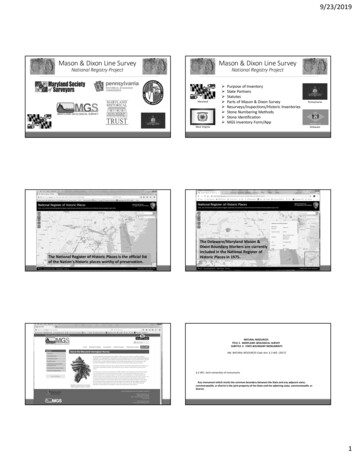
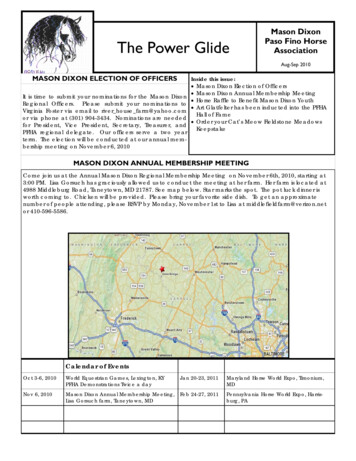


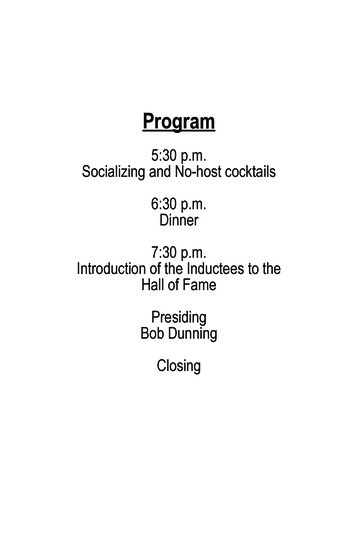
![[403] Vol. Cccxxxviii Over the Counter Sales 3.40 Including G.s.t .](/img/27/22195-gazette-11-may-2022.jpg)
